Camels In Australia
About The Australian Outback And The Camels There
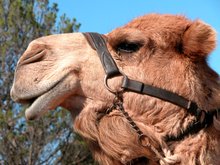
Yes, we have camels in Australia, or more specifically in the Australian Outback deserts. Lots of them.
In fact, Australia's wild camel population is the biggest in the world.
Everybody knows that camels are not native to Australia. Nevertheless, they are perfectly suited to the Australian Outback environment. Made for it, so to say.
A lot of Outback Australia is classified as desert, and camels are desert animals. Of course it suits them here. So much so that lately the camels in Australia have become a bit of a problem...
- How camels arrived in Australia
- Camels, the perfect transport solution for the Australian Outback
- The Australian camel population today
- See wild camels in Australia, camel farms and camel safaris
How camels arrived in
the Australian Outback deserts
The very first camel to ever set foot on the red Australian soil arrived in 1840 and came from the Canary Islands. (This was a somewhat unlucky camel, as it accidentally caused its owners death and was subsequently shot...)
But this first camel was soon followed by others. 24 more camels arrived in Australia in 1860 to be part of the Bourke and Wills expedition. And in the next fifty years an estimated 10 000 to 12 000 camels made their way to Australia!
The camels came to Australia mostly from India and Palestine, and nearly all of them were dromedaries (the one humped variety Camelus dromedarius). Apparently there were only about 20 two humped camels (bactrian camels of the species Camelus bactrianus) imported during that time.
On top of that Australians also started breeding their own camels. The first of several Australian camel studs was established in 1866 in South Australia, and the studs went on to operate for fifty more years. (Interestingly the working camels bred in Australia turned out to be of much higher quality than the imported camels...)
Camels proved to be the perfect
transport solution for the Australian Outback
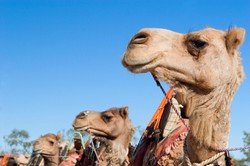
- Camels can go without water for long times.
- Of the estimated 350 or so plant species that grow in the Australian Outback deserts, camels eat 325!
- Camels don't need roads. Their huge feet allow them to easily walk over soft sand that would bog anything with wheels.
- Camels don't need shoeing like horses do. They do need constant work to be happy. (Horses need a spell when they've been working under extreme conditions for too long.)
- Also, a camel is old enough for light pack work at only three years of age, and can go on to work at least until it's forty. That's a long working life.
- The loads that camels can carry are impressive, too. A grown bull camel will carry up to 600 kg!
It was the camels, and the camel drivers or cameleers, that opened up the Australian Outback. The camel drivers came mostly from Afghanistan, but also from Pakistan and the Turkish Empire.
(The iconic train that traverses the Australian Outback today, the Ghan, is named after those Afghan camel drivers.)
The camels and the cameleers, their endurance, knowledge and labour skills, were crucial in the Australian Outback in the early days. Not only the first explorers relied on camels as they traversed the inhospitable Australian desert regions.
All the key projects that made the Australian Outback accessible for us Europeans depended on the camels and their drivers as well. (Projects like the Overland Telegraph Line from Adelaide to Darwin, the Transcontinental Railway Line or the Canning Stock Route, to name just a few.)
The Australian Camel Population Today
Progress and development took their usual course. By the 1920s the camels' working days were numbered. Roads, railway lines and airstrips were built, and eventually the camels couldn't compete with the roadtrains, the cessnas and the locomotives any more.
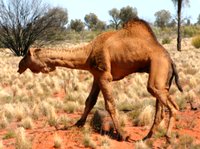
Even when they were still working, some camels in Australia escaped or were simply let go. Now that they weren't needed any more large camel herds were set free in the Australian Outback deserts and, uh, lived happily ever after....
Camels do very well in our Australian Outback deserts, I pointed out why. Turns out that they are doing a little bit too well...
The camels in Australia multiplied, and multiplied, and keep multiplying... They live in the arid central deserts, half of them on the Western Australian side, another quarter in the Northern Territory, and the rest in South Australia and Queensland.
Nobody knows how many there are exactly now (2012), some say around 600 000, some say they he numbers have reached at least one million. All agree that there are too many, and the number is expected to double again in the next eight years.
The Australian Outback currently has to cope with an extended draught, and the camels are thirsty. Even camels need water eventually, and in their search for water they have become a serious problem.
They overrun Aboriginal communities to get to taps, wells and air-conditioners, they ruin water holes and water troughs on cattle stations, people had to shoot them to keep them out of houses...
In the worst affected areas cattle station owners spend 80% of their maintenance budget on fixing camel damage, some up to A$ 60 000 a year! Some properties have over 2000 camels on their land. The owners are at their wits end and are talking about giving up and just handing the pasture over to the camels...
Camels are also a threat in the undeveloped desert regions. They compete with native animals for food and water, they are destroying Aboriginal sacred sites, Aboriginal food sources, national parks, anything in their path basically. Camels are seriously upsetting the balance of the fragile Australian desert ecosystem.
At the moment there is mostly a lot of noise and pleas that something needs to be done. Culling will need to be part of the solution, no doubt, but most people realise that the Australian camels are also a valuable resource.
The goal is to make the best use of this resource, so it provides a financial benefit to the affected indigenous communities and also to the station owners. There is talk about growing the existent and developing new export markets. The demand for camel meat in Australia (both for human consumption and as pet meat) will never be big enough to make a dint in the camel population...
Let's see what happens and what our politicians can come up with.
Where To See Camels In Australia
Camel Farms And Camel Safaris
If you travel through central Australia chances are you will see camels. They're everywhere... The biggest herds live in the desert regions near the borders of Western Australia, the Northern Territory and South Australia.
Watch out, because they stand on the highway, too, and you don't want to hit one.
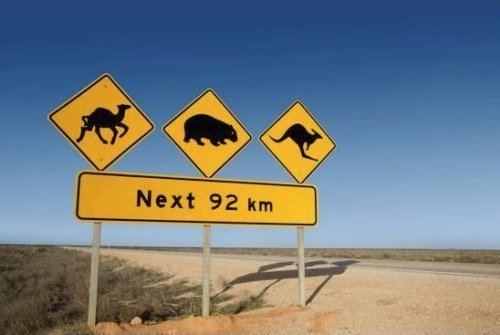
Kangaroo Warning Sign Australia
If you won't be here for long and want to make sure you see camels, or if you want a closer encounter, seek out one of the camel farms.
There are over 50 Australian camel farms, trying to lure domestic and international tourists. You can go for a ten minute camel ride, or a three week camel safari.
Most camel farms are in Western Australia or the Northern Territory, there are some in Queensland and South Australia, and even some in Victoria and New South Wales although those states don't have any wild camels. You should be able to find one wherever you are.
Popular rides are the short rides (tourists, always in a rush...), like for example the ones offered by camel farms in the Alice Springs/Uluru area where all the big coaches stop, and also the well known camel sunset rides on famous Cable Beach in Broome.
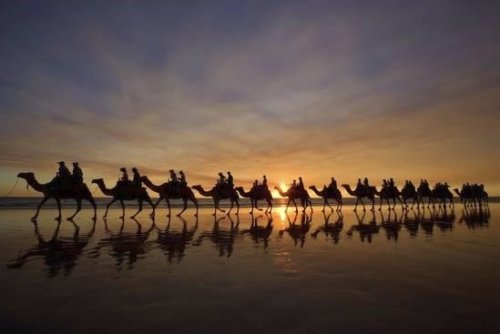
Camel Safari on Broome's Cable Beach, Australia
But if you'd like to do something different, have a real Australian Outback experience, there are proper camel safaris that go over several days. You don't have to do the extreme three week desert crossing, but why not go on a three day camel safari in Australia, and spend a couple of nights under the stars? Get a feel for what the Australian Outback is really like...
Return to Australian Desert Animals
All Australian Animals | Australian Outback Animals
Find more articles and information about the Australian Outback
Return from Camels Australia to Outback Australia Travel Guide home page





